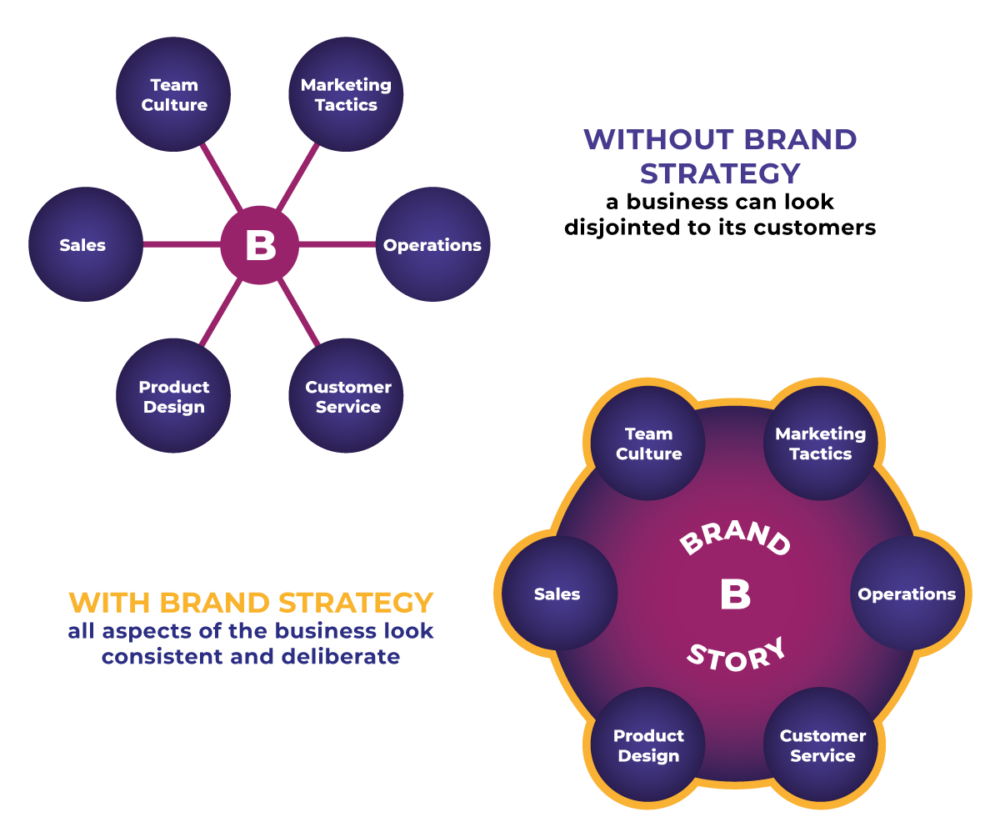By Dr. Marina Hauer, Brand Development Consultant at Apricity Studio, and Expert Speaker on the Help to Grow Management course at Cardiff Met.
Most SMEs don’t have a defined brand strategy. This is because busy business owners commonly dismiss it as something big, complicated, and expensive. Something Coca-Cola would need, or the BBC.
We hear ‘strategy’ and picture Generals around a giant map table. We picture pages and pages of diagrams, what-ifs, and then-whats. And indeed, most consultants probably reinforce that notion.
And without a clear understanding of the benefits a brand strategy could bring, most small business owners just run their operations on instinct.
But in truth, the brand strategy should never be complicated. There is a very simple way of reframing this seemingly ambiguous topic.
Reputation and your brand strategy
In a previous article, we discussed that brand is essentially reputation. It is what people say about you when you’re not in the room, how you made them feel, and what they remember from having dealt with you.
This means that brand strategy is an intentional plan for garnering a certain reputation.
In plain terms, brand strategy is simply:
- Deciding what you want to be known for.
- Analysing where you are now, and
- Coming up with ways of bridging the gap.
Defining your brand strategy
Defining your brand strategy benefits more than just your visibility, it spans your whole business, giving you multiple benefits:
Improved clarity (internal) – especially with growing teams
The more businesses and teams grow, the more critical it is to be clear about what the brand stands for, what it promises to its customers, and how everybody involved can contribute to the success of the mission.
The more people sing from your hymn sheet, the better it needs to be distributed. This team-wide clarity can be used as a guiding principle for decision-making, especially in situations of unexpected change or difficulty.
One of the case studies used in the Help To Grow brand workshop that I deliver, illustrates clearly how a well-defined brand strategy can even help a brand pivot into new markets.
Improved clarity (external)
Without a brand strategy, a business can function well but look a little disjointed to its customers. This can create confusion, and even mildly confused customers usually go to buy somewhere else.
But, if a brand has internal clarity on what it wants to be known for, that clarity translates into a consistent, deliberate image when viewed from the outside. The brand looks ‘together’. This cohesion gives a sense of trustworthiness, and professionalism and makes it easy to recommend that brand.

Clearer direction and vision
Working towards a clear reputation also helps with all kinds of decision-making:
- Who not to advertise to because it won’t get you where you want to be.
- What to add to (or drop from) your products, or service packages.
- How to speak to your audience, prospects, or clients.
- How to show up publicly, and what to openly stand for (and against).
- Where to add little flourishes to your marketing or delivery.
- How to differentiate yourself against your competitors, and even what to charge.
And because the whole team is on board with it, they can contribute impactful ideas and positive changes organically and purposefully.
More inspiration
Another benefit of a team on a clear mission is the fantastic cross-pollination of insights, ideas, motivation, and inspiration. They will find ways to delight their customers in ways that add to the brand’s equity. In turn, this leads to happier customers and more fulfilled team members.
Differentiation in the marketplace
Standing out is much easier when you know what you stand for. Or against. And remember, most other SMEs operate without brand strategies.
You’ll be surprised how easy it is to gain an edge simply by looking like the more consistent, more trustworthy, and therefore more assured choice. And all of this leads to targeted growth, one interaction at a time.
How to design an impactful brand strategy
Start by seeing every touchpoint with a customer as a chance to add brand equity. Create a good experience: add +1. Negative or neutral experiences count as -1. Naturally, the aim is to be overwhelmingly in the black.
After this mindset shift, jump into the detail.
- Choose a reputation goal – if you could only have a glowing reputation for one thing, what would that be? Then choose two other reputational goals that support/supplement the main one.
- Audit your current brand:
- What are you currently known for? You might have to ask or use social listening.
- What do you know you do well?
- Which areas of your business don’t add to your brand equity – try to pinpoint specific areas for improvement (the more detailed the better) e.g. product/service design, delivery, customer service, marketing, sales, and employee engagement.
- Devise a plan for each of the identified improvement areas, to bring your current way of operating more in line with your reputation goal.
While adhering to a brand strategy will see growth simply due to the fact you’re looking more ‘together’, it’s a game of incremental gains.
Brand equity is notoriously hard to measure – but that doesn’t mean it’s not worth doing. Reputation and customer loyalty projections are a key aspects of business valuations when it comes to exiting.
The Help To Grow Management course dedicates two whole sessions to mission, values, and their importance in brand building, and with good reason. It’s extremely valuable to a business to be able to articulate why they exist, what problems they solve in the world and why that matters.
In the Help To Grow course, this culminates in an interactive workshop in week six, where participants experience first-hand what it takes to turn values and beliefs into reputation-building, strategic business communication.



